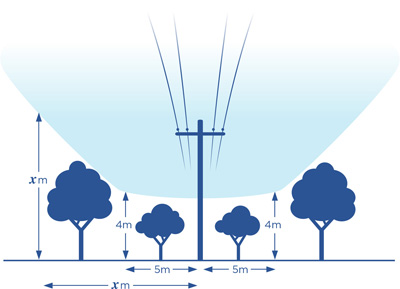Plant smart
Trees enhance our homes and provide shade and privacy. But trees may contact powerlines and interrupt power supply during storms and high winds. To help prevent this happening, and to ensure the safety and reliability of your power supply, you need to plant smart.
For the service line, the one that connects power to most homes, trees can safely grow quite close, even brushing it lightly, and not cause a problem.
REMEMBER - Never attempt to trim trees or other vegetation near powerlines yourself. Call a professional tree trimmer to trim any trees near powerlines
Before you plant
Consider how high and how wide your tree will grow. If planting near powerlines, choose a low-growing, powerline-friendly species. Check our Plant smart search for powerline friendly plants in your council region.
Before you plant:
- Plan where you are going to plant. Plants must be at least three metres from power poles. Plant shrubs or small trees one metre inside the kerb where the council footway is a minimum of four metres wide. Allow for at least a two metre gap between the service wire to your home and the height of mature trees.
- If your tree will grow to five meters, you should plant it five meters away from the power pole. If it will grow to ten meters, it should be ten meters away. Keeping trees away from powerlines helps keep the power on and you safe.
- Check with your council for planting guidelines, especially if planning to plant on your council footway. Residents who wish to plant trees on council-controlled land in locations other than streets or council footways, may need written permission.
- Consider the location of overhead and underground services, including the service line to your home. Visit Before You Dig Australia to request information about underground cables on or near your property.
- Check the visibility from your driveway, intersection sight lines and access to your property.
- Consider pedestrian traffic, mail service and garbage truck access.
- Check required clearance from street lights.
- Consider which type of tree you should plant. Choose a powerline-friendly plant. Check with your local plant nursery or council for recommendations.
The diagram below shows the recommended minimum distance between a pole and a grown tree, and the desired maximum grown height of trees under powerlines

Trees and powerlines
Skip to descriptionTrees and powerlines can be a dangerous combination, presenting a risk to public safety and causing problems with power supply.
When planting trees on a property, choose a powerline friendly tree. If you’re unsure check with your local plant nursery or council.
Make sure to plant all trees and plants at least 5 metres from powerlines.
Allow a two metre gap between the service wire - that’s the line running from the overhead power lines to your house - and the full height of mature trees.
Don’t forget about the risk below either. Contact /Dial Before You Dig/ to locate any underground services before you do any digging.
Vegetation maintenance is also important when it comes to power line safety. Trim trees and shrubs to maintain safe clearance around the electricity service line.
If you need to clear trees or trim vegetation using machinery, call us first for safety advice. Never attempt to trim trees or vegetation near power lines yourself, always use a professional tree trimmer or arborist.
Before starting work take the time to plan.
Download our Look Up And Live app to identify powerline locations and stay safe when working on trees and shrubs near powerlines.
Trees and powerlines safety tips
This video explains that trees and powerlines can be a dangerous combination, presenting a risk to public safety and causing problems with power supply. Make sure to plant all trees and plants at least 5 metres from powerlines.
How to plant a tree so that it thrives
- Dig a hole 300mm from the edge of the root ball on the tree
- Loosen up the sides of the hole to promote root penetration
- Water crystals can aid in water retention
- Create a well around your tree with soil to help retain water and reduce water run-off
- Place mulch to a depth of 150mm around the base of your tree, but away from the trunk to prevent rot
- Thoroughly water each tree immediately after planting and as required
- Once planted, water the tree regularly in dry weather (check under the mulch to see if the soil is dry). Even so-called drought-tolerant plants need to be watered regularly until their roots become established.
- Native trees can be fertilised for much better growth. Use a fertiliser that is low in phosphorus, marked as ‘P’ on the label of the bag. To determine if your fertiliser is suitable, check the N:P:K (nitrogen - phosphorus - potassium) composition. Use one that contains less than 3% P; those with low P but high N and K are fine, e.g.11:2:13.
Unsuitable trees
Some trees just aren't suited to growing near powerlines. Trees which grow fast and tall are the most hazardous, as well as those which tend to drop large branches during storms. If a plant is assessed as posing a risk to electrical safety or power supply, our contractors will negotiate with the landholder to remove it.
Regular culprits of power interruptions and safety hazards include:
- Bamboo species
- Tall palms
- Climbing vines
- Tall Eucalyptus species
- Camphor Laurel (Cinnamomum camphora)
- Pepperina/Peppercorn tree (Schinus molle var. areira.).
Additionally, there are known varieties of trees which don't perform well in storms and cyclones, these include:
- Yellow flame tree (Peltophorum pterocarpum)
- African mahogany (Khaya senegalensis)
- River blue gum (Eucalyptus tereticornis)
- Weeping fig (Ficus benjamina)
- Pink trumpet tree (Tabebuia impetiginosa).

